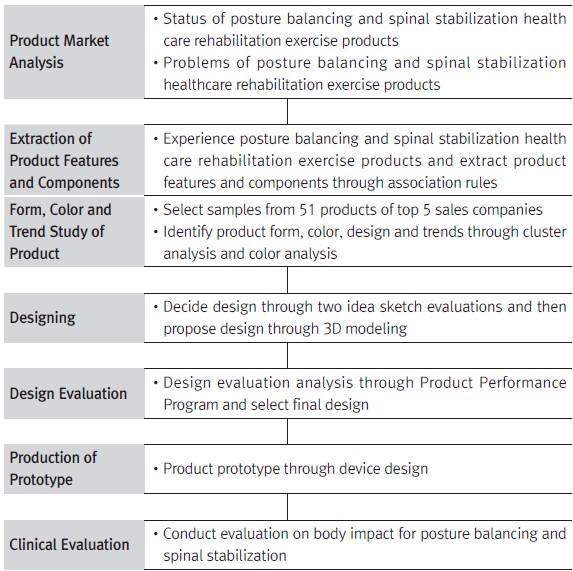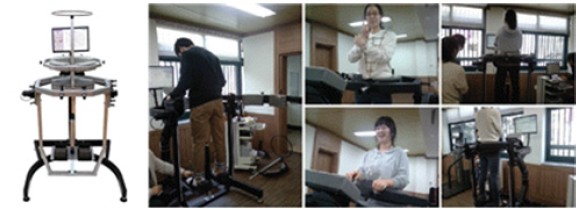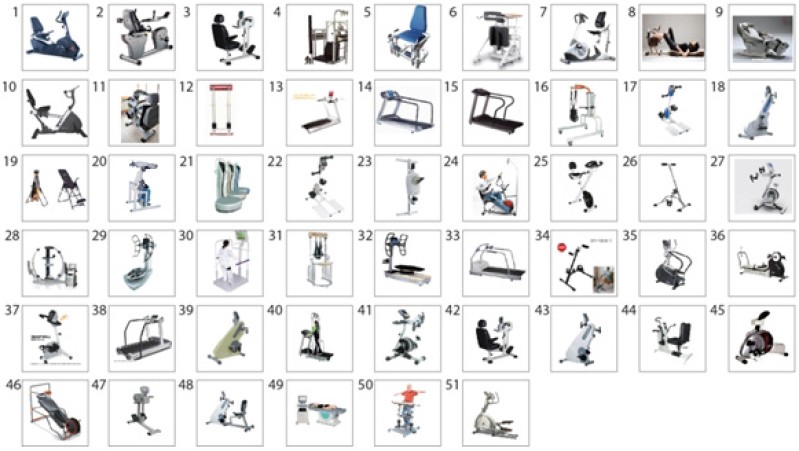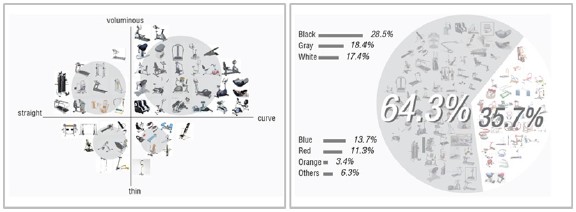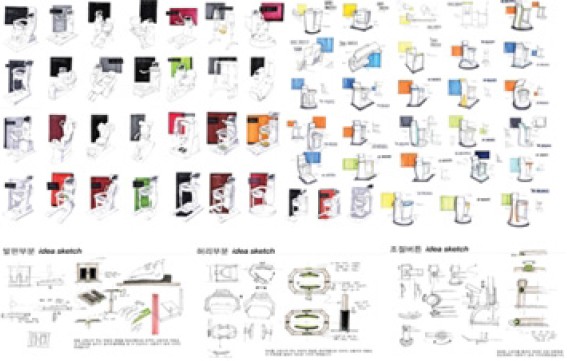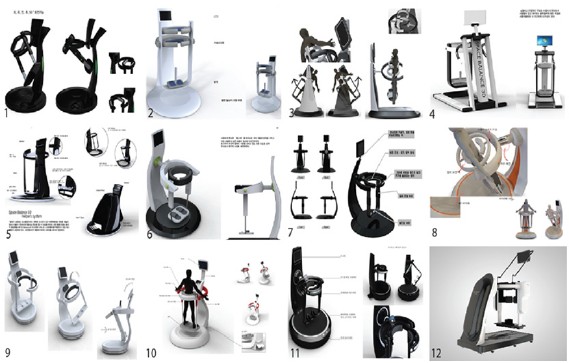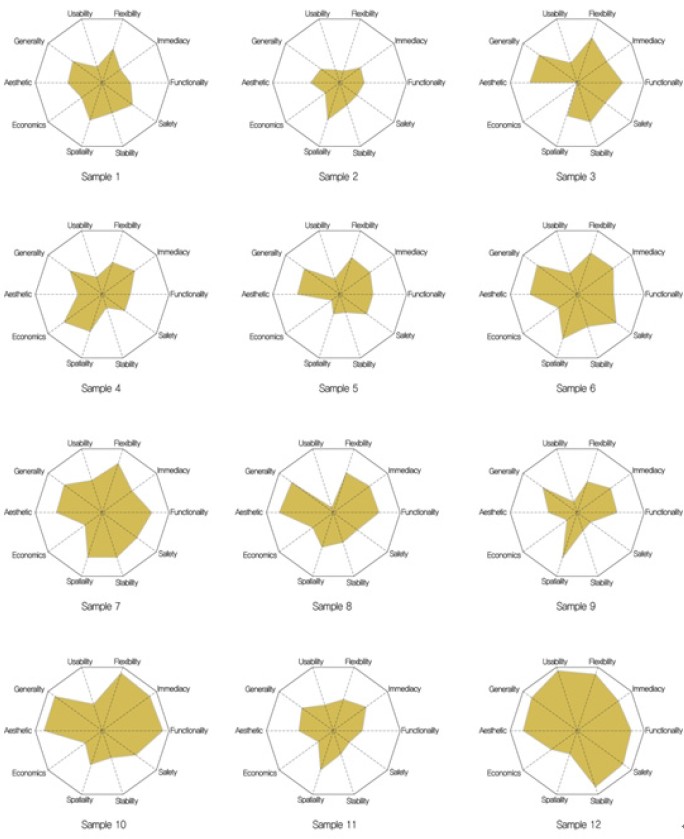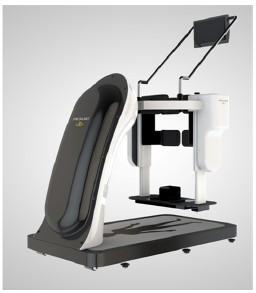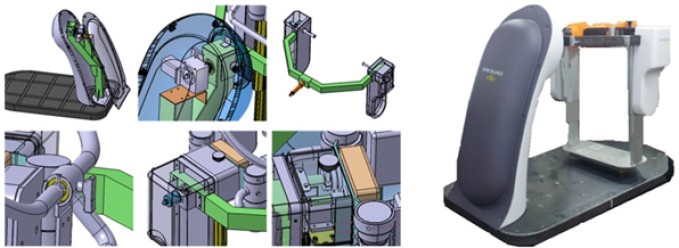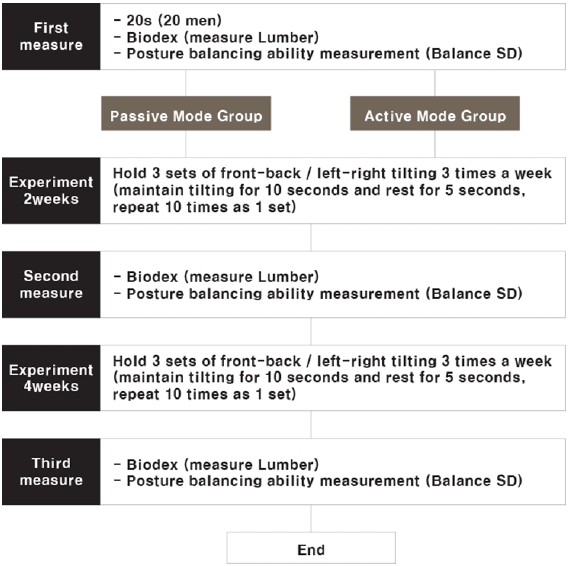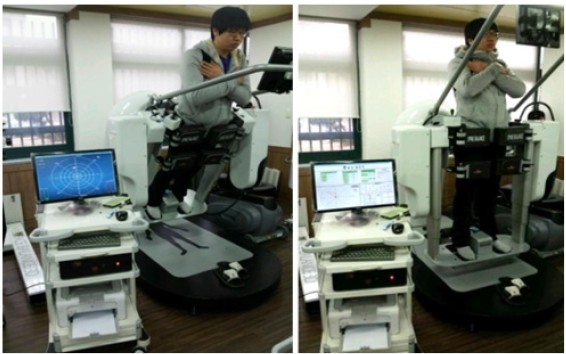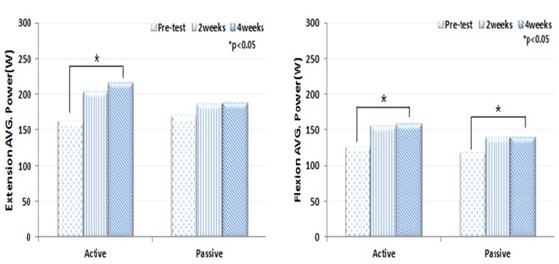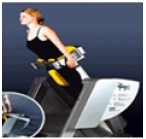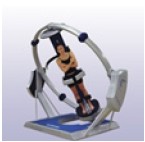
A Study on the Development of the Design of a Health Care Rehabilitation Trainer for Posture Balance and Spinal Stabilization
Background As interest in personal health continues to increase in Korea due to improved income levels and five-day workweek, individual participation in sports activities has increased. Because participants often fail to warm up properly, wear protective gear, or exercise in moderation and lack training in proper sports skills, the risk of spinal injuries among such sports participants has grown as well. Furthermore, due to a rise in average life expectancy and drop in birth rates, Korea is becoming an aged society faster than any other country. People with motor difficulties, the aged and the disabled are at greater risk of injury when exercising and are prone to degenerative or agerelated diseases resulting from a decline in their physical functioning. Therefore, there is a growing need for spinal stability rehabilitation exercise machines that are not physically demanding and are easy and safe to use. A concurrent need also exists to increase the will of those suffering from spinal diseases and injuries to rehabilitate while not depending on surgery while at the same time improving public perception of surgical option for treating spinal diseases. Thus, the development of health care systems and device designs are necessary.
Method This study carried out the following research process for the development of design for a posture balancing and spinal stabilizing health care rehabilitation exercise system. First, the status and problems associated with domestic and foreign posture balancing products and spinal stabilization health care rehabilitation exercise systems were examined. Second, based on two product analyses for designing, two rounds of idea sketches evaluated and a design was proposed using 3D modeling. The proposed designs then underwent PPP (product performance program) evaluations using the ten evaluation criteria from a universal design perspective to select the most ideal design. The selected designs were used to produce a prototype through device designs and posture balance and spinal stabilization body effects evaluations were conducted to verify whether the developed products were effective for posture balancing and spinal stabilization rehabilitation exercises through the final stage of clinical testing.
Results Initial product analysis results show that a health care rehabilitation trainer for posture balance and spinal stabilization should be designed with consideration given to the areas of structure, aesthetic, functions and use.
A second product analysis shows that the current market trend is toward voluminous and curved forms with color combinations of black, grey and white.
The design finally decided through PPP evaluations were produced as prototypes, which then underwent clinical evaluations. Clinical test results show that the backbone erector muscle and rectus abdominus, which are related to the lumbar joint, were strengthened. Therefore, through treatment and training using this product, it is judged that the product will produce rehabilitation training effects for spinal stability and posture balance.
Conclusion In order to carry out this study based on objective and quantifiable data, design factors were extracted based on theoretical considerations and two user-oriented tests. The extracted data was used to create the design and the optimal design was selected through PPP evaluation. In addition, clinical evaluations were conducted by producing prototypes and it was judged that the device was effective in improving spinal stability and posture balance.
Three achievements were made through this research.
First, this study is on medical rehabilitation device designs and it found user needs through user-oriented experiments. Based on this, various designs were proposed. These designs underwent PPP evaluations by experts in various sectors using ten universal design factors, and the health care rehabilitation trainer for posture balance and spinal stabilization design that best applied the universal design factors was selected.
Second, clinical tests were conducted on the final design by producing a prototype. It was proven that carrying out rehabilitative training with this product strengthens the backbone erector muscle and rectus abdominus related to the lumbar joint, making it effective for posture balance and spinal rehabilitation training. This step ensured the safety and reliability of this research.
Lastly, this study focuses on user-oriented process for developing the design for a health care device that combines design, engineering and medicine. It has value as convergence design research and can be used for similar design developments.
Furthermore, user-oriented health care device design development cases that complete product verification through clinical evaluations can be used for developing similar designs.
Because the clinical evaluations conducted for this study did not employ senior citizens, the disabled, and patients with spinal ailments, it should be supplemented in the future through design usability evaluations and clinical evaluations.
Keywords:
Postural Blance, Spinal Stabilization, Healthcare Design, Medical Appliance Design, Universal Design1. Introduction
1.1. Background and Purpose of Research
Due to the increase of average life expectancy and drop in birth rates, Korea is entering the aged society faster than any other country. According to a press release by Statistics Korea in 2008 titled 'World and Korean Populations', compared to the population between 15 and 64 years of age in Korea, the percentage of those over 65 years of age is expected to increase to 72% in 2050 compared to 15% in 2010.
In such aging society, health care products are, unlike general products for improving health, for exercise therapy for quick recovery of patients with various elements that interfere with their daily lives and for disabilities due to various diseases. Degenerative diseases or age-related diseases due to lower physical functions because of aging or disabilities can easily appear for the aged or persons with disabilities who have motor difficulties making it difficult to exercise or have risk of injury during exercise. The aged or disabled need exercise that strengthens muscular strength or balancing abilities. However, it is difficult for them to exercise alone and need assistance from others, and they are at high risk of accidents while exercising, and therefore, they tend to lack exercise. Due to such reasons, they need health care systems and devices that can let them exercise easily and safely without having too much physical burdens.
According to a study by Jaseng Hospital of Oriental Medicine (2007) on 40,000 back disk patients from January 2005 to May 2007, leisuretype disk patients that accounted for 19% of total disk patients in 2005 rose to 26% in 2006 and 28% in 2007. With increased income levels and five-day work weeks, there has been a continued increase in personal health and more participation in sports activities. However, due to lack of warming up, lacking exercise skills, excessive exercise, and lacking protective equipment, there has been a proportionate increase in back injuries.
According to the Korea Consumer Agency in 2004, in proportion to the increase of spinal surgery, there has been an increase in medical disputes. Furthermore, with the growing negative perception of surgery among spinal injury patients and the growing will to rehabilitate without depending on surgery, there has been an increase in demand for rehabilitation exercise devices.
Therefore, this study aims at identifying design factors and problems through experience of existing products from the perspective of health care design for senior citizens, the disabled and patients requiring spinal rehabilitation, while suggesting the direction for a new rehabilitative exercise system design development for posture balancing and spinal stabilization.
1.2. Range and Method of Research
This study carried out the following research processes for the development of posture balancing and spinal stabilizing health care rehabilitation exercise system design. First, the status and problems with domestic and foreign products on posture balancing and spinal stabilization health care rehabilitation exercise systems were examined. Second, based on two product analysesfor designing, idea sketch evaluations were conducted twice and a design was proposed using 3D modeling. The proposed designs then underwent PPP (product performance program) evaluations using the ten evaluation items from a universal design perspective to select the most ideal design. The selected designs were used to produce a prototype through device designs and posture balance and spinal stabilization body effects evaluations were conducted to verify whether the developed products were effective for posture balancing and spinal stabilization rehabilitation exercises through the final stage of clinical testing.
2. Product Market Analysis
2.1. Status of Posture Balancing and Spinal Stabilization Health Rehabilitation Products
Recently in the health care sector, with convergence of rehabilitation medicine, IT technologies and the sports sector, various types of new products have been developed. In particular, the intelligent rehabilitation exercise device industry, which integrates IT technologies and biomedical engineering, has developed not only as exercise devices for health, but so that it can play diverse roles such as posture balancing and improvement of muscular strength for the elderly, disabled and persons who recently underwent surgical operations.
Currently, the posture balancing and spinal stabilization rehabilitation exercise system devices among health care rehabilitation systems are led by four domestic/foreign products in the Korean spinal rehabilitation market. 3D-Netwon is being produced as a product by a Korean company, but it falls behind in terms of advanced technologies of the US, France and Germany. Moreover, various clinical evaluations on training techniques applied to users were not made. There is no related database so research and technological development on this is urgently needed.
2.2. Problems of Posture Balancing and Spinal Stabilization Health Care Rehabilitation Exercise Products
Normally, the elderly are limited in their activities and have physical problems due to the decline of physical functions. As one grows older, their physical size becomes smaller than young adults and there are changes in their skeleton, while also experiencing difficulties in adjusting muscular motion due to a drop in stamina and hardening of joints. Due to such reasons, senior citizens have difficulty in motion, causing them move slowly, while having difficulty in sitting down, standing up and turning around. Thus, they feel discomfort in daily life and easily feel fatigue, while also having a smaller range of activity. Their decline of balancing abilities also increases their risk of falling. Because of such reasons, posture balancing and spinal stabilization exercises are being carried out mainly at rehabilitation clinics to prevent falling of the elderly. However, it has compound exercise effects such as enhancing muscular strength, trunk muscles, as well as improving the sense of balance. According Jung (2013), however, when examining the posture balancing and spinal stabilization rehabilitation exercise devices launched until now, it is difficult to motivate patients and the elderly for rehabilitation when using the rehabilitation system devices. Furthermore, users feel anxiety, lowering exercise effects, while the unfriendly designs unique to medical devices cause a sense of repulsion to users. In addition, as seen in the contents of <Table 1>, existing products are effective for improving muscular strength and trunk muscle strength, but there is no training to improve posture balancing abilities to enhance balance. Therefore, muscular strength improvement and posture balancing training is necessary for effective rehabilitation training of patients in spinal rehabilitation or with paraplegia.
3. Product Analysis
3.1. Extracting the Features and Components of Products
In the first product analysis, five design majors and five general persons visited the Chonbuk National University health center and examined the development direction and features of existing posture balancing and spinal stabilization health care rehabilitation product. By experiencing the posture balancing and spinal stabilization health care rehabilitation product in the center and applying association rules for analysis, the product features and components were extracted.
According to the results of the association rules study, the items perceived by all participants were categorized into the following 23 items as shown in <Table 3>. Important items include repulsion against the form, adjustment of monitor position and angle, difficult to adjust bed and screws, and complexity to use.

Posture Balancing and Spinal Stabilization Health Care Rehabilitation Device Experience Evaluation Results
Upon grouping similar meanings by arranging <Table 3> of the evaluation results, it can be categorized into the following four perspectivesas shown in <Figure 3>. For the structural aspect (29.3%), help from two or more people are needed for getting on and off the device, and the structural issue that did not take into consideration the individual physical ages of the users were the biggest issues. From an aesthetic aspect (24.5%), it was studied that it could be repulsive for users during rehabilitation exercise due to the cold and heavy material, form and color. From the usage aspect (22.3%), when using the device, it was found that users felt anxiety, lowering the exercise effects. From a functional aspect (19.2%), it was found that the position, size and operation of the functional factors such as the monitor, handle and fastening screws were uncomfortable.
3.2. Product Form and Color Trend Examination
In the second product analysis, 51 products from the top 5 companies in sales in 2011 were selected as samples to examine the form and color trends of posture balancing and spinal stabilization health care rehabilitation exercise productsas shown in <Figure 4>.
Five design majors and five health care device experts conducted clusteranalysis through individual interviews for the selected samples.Ten experts grouped the 51 samples with similar features and then a group analysis was conducted using the SPSS statistics program.Analysis results using SPSS statistical analysis were mainly made up of voluminous and curved products, and 64.3% of the products were a combination of black, grey and white colorsas shown in <Figure 6>.
4. Designing
4.1. Design Concept
Upon identifying and analyzing the product status, based on the contents conducted in the first and second experiments, the design concept for the posture balancing and spinal stabilization health care rehabilitation device was set as following.
From the structural aspect, up and down adjusting slide and hip fastening device modules to take into consideration individual physical difference; from an aesthetic aspect, voluminous and curved form with a combination of black, grey and white; from a user aspect, a muscular strength and motion angle sensing module' and from the functional aspect, self-diagnosis and administration through feedback on amount of exercise when using it for improving physical capacities were applied. It was given a universal design that placed utmost priority on safety and convenience of use for the elderly, disabled and patients with spinal ailments, while also designing it from the user's perspective so that they may feel physical stability.
4.2. Idea Sketch and 3D Modeling
It was sketched focusing on the concept deduced through the experiment, and idea sketch evaluations were conducted two times. Also, ten design majors and ten health care experts made multiple votes to summarize them into twelve sketches, and 3D modeling was conducted for these concepts.
5. Design Evaluation
The PPP (Product Performance Program) evaluation was made for the 12 modeling designs by 10 designers, 10 health care experts, and 10 other related persons using the 7 principles and 3 sub-principles for universal design (usability, flexibility, immediacy, functionality, safety, stability, spatiality, economics, aesthetics, generality)as shown in <Table 7>.
Of the various factors that make up the product, the questions on 'which part is convenient to use and how much' and 'what kind of problems occur and where' were evaluated and verified in detail and systematically. Evaluation results showed that design 12 scored high in all areas excluding spatiality and economics so it was decided as the final design.
6. Production of Prototype
A prototype was produced for the design that was finally selected through PPP evaluations. The prototype was designed for spatial revolution motion in 3D angles, front and back motions, and diagonal motions. It was also designed to be possible to change from active and passive modes in order to make it possible for patients to engage in rehabilitation exercise according to their condition. Furthermore, it was designed so that the user's spine position can be adjusted as well as the head position, while also making it possible to move the center of the waist from the back of the disk to the spinal joints. Thus, this design offers stability during use and rehabilitation exercise so that users can concentrate only on exercise.
7. Clinical Evaluation
In order to verify whether the finally developed prototype is effective for posture balancing and spinal stabilization rehabilitation exercise, an evaluation on the bodily effects of posture balancing and spinal stabilization was carried out.
7.1. Clinical Evaluation Method
Clinical evaluation was conducted using the produced prototype. Clinical evaluation was conducted on twenty healthy male adults in their twenties at the Chonbuk National University Health Care Engineering Department. Ten were placed in the Passive Training Group (training that received motion angle by the equipment) and ten in the Active Training Group (training that received motion angle by the will of the subject) to conduct training to improve posture balancing and spinal stabilization abilities using the prototype. Biodex System 3 (Biodex medical system.Inc, USA) was used for evaluating trunk muscular strength and Balance System SD (Biodex medical system Inc, USA) for the posture balancing evaluation. They were measured two weeks and four weeks into the training to verify their effects.
7.2. Results of Clinical Evaluation
Results of the truck muscular evaluation showed that during lumbar extension, there was a 32% increase after about four weeks compared to before exercising for the active group. Meanwhile, in the passive group, there was about an 11% increase. During lumbar curve, average power increased by about 25% and 18% for the active and passive groups, respectively. This represents that through this exercise, the backbone erector muscle and rectus abdominalis related to the lumbar joint were strengthened.
In the posture limit evaluation, it was found that there was a 42% increase and 31% increase for the active and passive group, respectively, compared to prior to the exercise. This represents that muscle groups used for directional motion were all improved. Results of the posture stability evaluation showed a drop of -10% and -11% for the safety index. It is judged that since there was no significant difference, there was no effect on reducing trunk wavering.
According to the clinical evaluation results, therefore, it is judged that through therapy and training with this product, rehabilitation exercise effects can be expected for spinal stability and posture balancing.
8. Conclusion
This study evaluated the product usability application plan from the user's perspective through product market analysis and two product analyses, and identified product form, color and trends through cluster analysis and color analysis. Furthermore, this was a case in developing a user-oriented posture balancing and spinal stabilization health care rehabilitation device design development that can be accurately assessed through PPP (product performance program) and clinical evaluations.
The conclusions from this study are as follows.
First, it is evident that in addition to the aesthetic aspects of designs, psychological aspects and consideration for users such as its structure and functions are important for medical rehabilitation device products.
Second, development of health care medical device design must have its design results evaluated by a medical and/or health care expert to detect biased design elements or to resolve problems from evaluations. Also, the therapeutic effects of the product must be verified through clinical trials by producing a prototype.
Lastly, this study found optimal designs through user-oriented tests and PPP evaluations. Furthermore, through the user-oriented health care device design development cases that completed product verification through clinical evaluations can be used for developing similar designs.
9. Future Research
Because this study did not conduct evaluations of actual users such as senior citizens, the disabled, and patients with spinal ailments, it should be supplemented in the future through design usability evaluations and clinical evaluations.
Acknowledgments
This work was supported by the Research and Business Development of 2012.
Notes
This is an Open Access article distributed under the terms of the Creative Commons Attribution Non-Commercial License (http://creativecommons.org/licenses/by-nc/3.0/), which permits unrestricted educational and non-commercial use, provided the original work is properly cited.
References
- Statistics Korea. (2009). World and Korean Populations. Retrieved from http://kostat.go.kr/portal/korea/kor_nw/2/2/6/index.board?bmode=read&aSeq=65566.
- Korea consumer agency. (2004). Increase of Medical Disputes due to Spinal Surgery Complications. Retrieved from http://www.kca.go.kr/modules/board/view.jsp?&menuNo=294&boardConfigNo=129&boardNo=9809&ctx=0102.
- Jaseng Hospital of Korean Medicine. (2007). “Injured Back while Hiking” Increased Leisure-type Disk Injuries. Retrieved from http://www.mt.co.kr/view/mtview.php?type=1&no=2007072410341757348&outlink=1.
- Jung, H. (2013). Market Trends of Posture Balancingand Spinal StabilizationRehabiliation Devices. Workshop on the Development of Postural Balance.
- Cho, J., Kwon, T., & Hong, J. (2013). A Study of Development of ealthcare Apparatus Design for Postural Blance and Spinal Stabilization. Proceeding of Korean Society of Design Research, 2013 Spring International Conference , 128-129.
